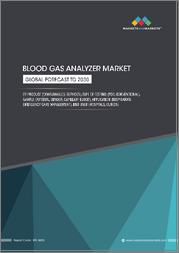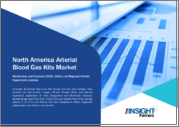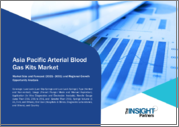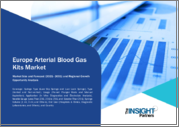
|
시장보고서
상품코드
1685167
혈액가스 및 전해질 분석기 시장 : 기회, 성장 촉진요인, 산업 동향 분석(2025-2034년)Blood Gas and Electrolyte Analyzers Market Opportunity, Growth Drivers, Industry Trend Analysis, and Forecast 2025 - 2034 |
||||||
세계의 혈액가스 및 전해질 분석기 시장은 2024년에 19억 달러에 달했으며, 2025년에서 2034년까지 연평균 성장률(CAGR) 5.2%로 성장할 것으로 예측됩니다.
이러한 성장은 당뇨병, 호흡기 질환, 신장 질환, 심혈관 질환과 같은 만성 질환의 유병률이 증가함에 따라 혈액가스 및 전해질 수치를 자주 모니터링해야 하는 만성 질환의 증가에 힘입어 촉진되고 있습니다. 의료 서비스 제공업체는 정확하고 시기적절한 진단 결과를 보장하여 중환자 치료 환경에서 환자 치료 결과를 개선하기 위해 이러한 분석기를 점점 더 많이 채택하고 있습니다. 병원, 응급실, 중환자실(ICU)에서 실시간 의사 결정을 위해 이러한 기기에 의존하면서 현장 진단(POC) 솔루션에 대한 수요가 증가하는 것도 시장 확대에 중요한 역할을 하고 있습니다.
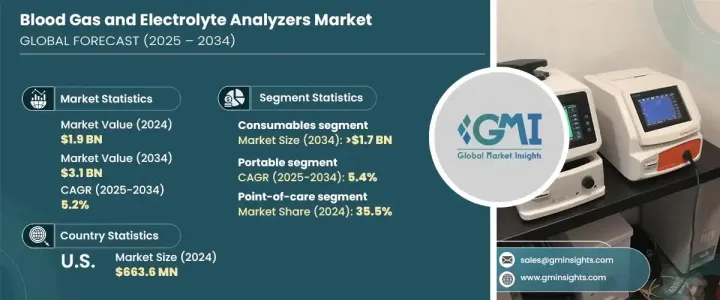
기술의 발전은 혈액가스 및 전해질 검사 환경을 변화시켜 접근성과 효율성을 높였습니다. 휴대용 분석기의 개발로 의료 전문가가 환자의 침대 옆에서 검사를 수행할 수 있게 되어 진단과 치료의 지연을 최소화할 수 있게 되었습니다. 또한 자동화와 전자 건강 기록(EHR)과의 통합으로 워크플로우가 간소화되어 오류가 줄어들고 효율성이 향상되었습니다. 질병의 조기 발견과 개인 맞춤형 의료에 대한 강조가 증가하면서 중환자에 대한 지속적인 모니터링과 조기 개입이 가능해져 이러한 분석기에 대한 수요가 더욱 증가하고 있습니다. 또한 전 세계 인구의 고령화와 함께 의료 인프라에 대한 투자가 증가함에 따라 고급 진단 도구의 채택이 증가하고 있어 제조업체와 이해관계자들에게 이 시장은 수익성이 높은 시장으로 부상하고 있습니다.
| 시장 범위 | |
|---|---|
| 시작 연도 | 2024년 |
| 예측 연도 | 2025-2034년 |
| 시작 금액 | 19억 달러 |
| 예측 금액 | 31억 달러 |
| CAGR | 5.2% |
시장은 휴대용 분석기와 벤치탑 분석기로 세분화되며, 휴대용 기기의 성장이 두드러질 것으로 예상됩니다. 휴대용 부문은 CAGR 5.4%로 확대되었으며 2034년에는 20억 달러에 이를 것으로 예측됩니다.이러한 급증은 주로 환자 관리에 있어 신속하고 정확한 결과가 중요한 응급실, 중환자실, 외래 진료 시설에서 현장 검사에 대한 수요가 증가함에 따라 이루어지고 있습니다. 휴대용 분석기는 이동성, 사용 편의성, 빠른 처리 시간 등의 이점을 제공하여 임상의가 중앙 집중식 실험실 테스트 없이도 신속한 의사 결정을 내릴 수 있도록 지원합니다. 홈 헬스케어와 원격 환자 모니터링의 증가 추세로 인해 이러한 소형 기기에 대한 수요가 더욱 증가하고 있으며, 기존 의료 환경 밖에서도 실시간 진단이 가능해졌습니다.
최종 용도의 관점에서 시장은 이 시장은 현장 진료 테스트, 중앙 실험실, 진단 센터, 병원 및 기타 의료 시설에 걸쳐 있습니다. 현장 진료 부문은 중환자 치료 환경에서 빠르고 정확한 진단 도구에 대한 긴급한 필요성에 힘입어 2024년 시장 점유율의 35.5%를 차지할 것으로 예상됩니다. 이러한 분석기는 즉각적인 검사 결과가 생명을 구할 수 있는 응급실, 수술실, 중환자실에서 중요한 역할을 합니다. 환자의 병상에서 실시간 인사이트를 제공하는 분석기는 처리 시간을 크게 단축하여 워크플로우 효율성을 개선하고 적시에 개입할 수 있도록 합니다. 외래 진료 및 재택 의료 환경에서 POC 분석기의 사용이 확대됨에 따라 시장에서의 입지가 더욱 공고해지고 있습니다.
미국의 혈액가스 및 전해질 분석기 시장은 2024년에 6억 6,360만 달러에 이르고, 2025년부터 2034년까지의 CAGR 성장률은 5%로 예상됩니다. 당뇨병, 심혈관 질환, 호흡기 질환과 같은 만성 질환의 발병률이 증가하는 것이 시장 성장을 촉진하는 주요 요인입니다. 이러한 질환은 혈중 가스 및 전해질 수치를 지속적으로 모니터링해야 하므로 신뢰할 수 있고 효율적인 진단 솔루션에 대한 수요가 증가하고 있습니다. 또한 미국의 인구 고령화로 인해 만성 및 급성 건강 문제의 위험이 높아지면서 병원, 진료소, 홈 헬스케어 환경에서 이러한 분석기의 채택이 증가하고 있습니다. 가치 기반 치료에 대한 관심이 높아지면서 POC 테스트 기술의 발전과 함께 미국 시장의 확장이 더욱 가속화되어 업계 플레이어의 주요 수익 창출원이 될 것으로 예상됩니다.
목차
제1장 조사 방법과 조사 범위
제2장 주요 요약
제3장 업계 인사이트
- 생태계 분석
- 업계에 미치는 영향요인
- 성장 촉진요인
- 세계의 만성 질환의 유병률 증가
- 기술 발전
- 통합 시스템에 대한 수요 증가
- 업계의 잠재적 위험 및 과제
- 제품과 관련된 높은 비용
- 성장 촉진요인
- 성장 가능성 분석
- 규제 상황
- 기술 상황
- 갭 분석
- 가격 분석
- Porter's Five Forces 분석
- PESTEL 분석
- 향후 시장 동향
제4장 경쟁 구도
- 소개
- 기업 매트릭스 분석
- 기업 점유율 분석
- 주요 시장 기업의 경쟁 분석
- 경쟁 포지셔닝 매트릭스
- 전략 대시보드
제5장 시장 추계 및 예측 : 디바이스 유형별(2021-2034년)
- 주요 동향
- 휴대용
- 벤치탑
제6장 시장 추계 및 예측 : 제품 유형별(2021-2034년)
- 주요 동향
- 소모품
- 복합분석장치
- 전해질 분석기
- 혈액가스 분석장치
제7장 시장 추계 및 예측 : 최종 용도별(2021-2034년)
- 주요 동향
- 현장 진료
- 중앙 실험실
- 진단센터
- 병원
- 기타
제8장 시장 추계 및 예측 : 지역별(2021-2034년)
- 주요 동향
- 북미
- 미국
- 캐나다
- 유럽
- 독일
- 영국
- 프랑스
- 스페인
- 이탈리아
- 네덜란드
- 아시아태평양
- 중국
- 일본
- 인도
- 호주
- 한국
- 라틴아메리카
- 브라질
- 멕시코
- 아르헨티나
- 중동 및 아프리카
- 남아프리카
- 사우디아라비아
- 아랍에미리트(UAE)
제9장 기업 프로파일
- Abbott
- Convergent Technologies
- Cornley
- EDAN
- Erba Mannheim
- Fortress Diagnostics
- Medica
- nova biomedical
- OPTI Medical
- RADIOMETER
- Roche
- SENSA CORE
- SIEMENS Healthineers
- Tecom
- Werfen
The Global Blood Gas And Electrolyte Analyzers Market reached USD 1.9 billion in 2024 and is projected to expand at a CAGR of 5.2% between 2025 and 2034. This growth is fueled by the increasing prevalence of chronic conditions such as diabetes, respiratory disorders, kidney diseases, and cardiovascular ailments, all of which require frequent monitoring of blood gas and electrolyte levels. Healthcare providers are increasingly adopting these analyzers to ensure precise and timely diagnostic results, improving patient outcomes in critical care settings. The rising demand for point-of-care (POC) diagnostic solutions has also played a key role in market expansion, with hospitals, emergency departments, and intensive care units (ICUs) relying on these devices for real-time decision-making.

Advancements in technology have transformed the blood gas and electrolyte testing landscape, making it more accessible and efficient. The development of portable and handheld analyzers has allowed healthcare professionals to conduct tests at the patient's bedside, minimizing delays in diagnosis and treatment. Additionally, automation and integration with electronic health records (EHRs) have streamlined workflows, reducing errors and improving efficiency. The increasing emphasis on early disease detection and personalized medicine is further driving the demand for these analyzers, as they enable continuous monitoring and early intervention in critically ill patients. Moreover, the growing investments in healthcare infrastructure, coupled with an aging global population, are pushing the adoption of advanced diagnostic tools, making this market highly lucrative for manufacturers and stakeholders.
| Market Scope | |
|---|---|
| Start Year | 2024 |
| Forecast Year | 2025-2034 |
| Start Value | $ 1.9 Billion |
| Forecast Value | $ 3.1 Billion |
| CAGR | 5.2% |
The market is segmented into portable and benchtop analyzers, with portable devices expected to see substantial growth. The portable segment is projected to expand at a CAGR of 5.4%, reaching USD 2 billion by 2034. This surge is primarily driven by the rising demand for point-of-care testing, particularly in emergency rooms, ICUs, and ambulatory care facilities, where rapid and accurate results are critical for patient management. Portable analyzers offer the advantage of mobility, ease of use, and faster turnaround times, allowing clinicians to make prompt decisions without the need for centralized laboratory testing. The growing trend of home healthcare and remote patient monitoring is further increasing the demand for these compact devices, enabling real-time diagnostics outside traditional healthcare settings.
In terms of end-use, the market spans point-of-care testing, central laboratories, diagnostic centers, hospitals, and other healthcare facilities. The point-of-care segment accounted for 35.5% of the market share in 2024, driven by the urgent need for fast and precise diagnostic tools in critical care settings. These analyzers play a crucial role in emergency rooms, operating rooms, and ICUs, where immediate test results can be life-saving. Their ability to deliver real-time insights at the patient's bedside significantly reduces turnaround time, improving workflow efficiency and ensuring timely interventions. The expanding use of POC analyzers in ambulatory care and home healthcare settings is further solidifying their position in the market.
The U.S. blood gas and electrolyte analyzers market reached USD 663.6 million in 2024, with an anticipated growth rate of 5% CAGR from 2025 to 2034. The increasing incidence of chronic diseases such as diabetes, cardiovascular disorders, and respiratory conditions is a major factor propelling market growth. These conditions require continuous monitoring of blood gas and electrolyte levels, driving demand for reliable and efficient diagnostic solutions. Additionally, the aging population in the U.S. faces a higher risk of both chronic and acute health issues, leading to greater adoption of these analyzers in hospitals, clinics, and home healthcare settings. The growing focus on value-based care, coupled with advancements in POC testing technologies, is expected to further accelerate the expansion of the U.S. market, making it a key revenue generator for industry players.
Table of Contents
Chapter 1 Methodology and Scope
- 1.1 Market scope and definitions
- 1.2 Research design
- 1.2.1 Research approach
- 1.2.2 Data collection methods
- 1.3 Base estimates and calculations
- 1.3.1 Base year calculation
- 1.3.2 Key trends for market estimation
- 1.4 Forecast model
- 1.5 Primary research and validation
- 1.5.1 Primary sources
- 1.5.2 Data mining sources
Chapter 2 Executive Summary
- 2.1 Industry 3600 synopsis
Chapter 3 Industry Insights
- 3.1 Industry ecosystem analysis
- 3.2 Industry impact forces
- 3.2.1 Growth drivers
- 3.2.1.1 Rising prevalence of chronic disease worldwide
- 3.2.1.2 Technological advancements
- 3.2.1.3 Increasing demand for integrated system
- 3.2.2 Industry pitfalls and challenges
- 3.2.2.1 High cost associated with product
- 3.2.1 Growth drivers
- 3.3 Growth potential analysis
- 3.4 Regulatory landscape
- 3.5 Technology landscape
- 3.6 Gap analysis
- 3.7 Pricing analysis
- 3.8 Porter's analysis
- 3.9 PESTEL analysis
- 3.10 Future market trends
Chapter 4 Competitive Landscape, 2024
- 4.1 Introduction
- 4.2 Company matrix analysis
- 4.3 Company market share analysis
- 4.4 Competitive analysis of major market players
- 4.5 Competitive positioning matrix
- 4.6 Strategy dashboard
Chapter 5 Market Estimates and Forecast, By Device Type, 2021 - 2034 ($ Mn)
- 5.1 Key trends
- 5.2 Portable
- 5.3 Benchtop
Chapter 6 Market Estimates and Forecast, By Product Type, 2021 - 2034 ($ Mn)
- 6.1 Key trends
- 6.2 Consumables
- 6.3 Combined analyzers
- 6.4 Electrolyte analyzers
- 6.5 Blood gas analyzers
Chapter 7 Market Estimates and Forecast, By End Use, 2021 - 2034 ($ Mn)
- 7.1 Key trends
- 7.2 Point-of-care
- 7.3 Central laboratories
- 7.4 Diagnostic centers
- 7.5 Hospitals
- 7.6 Other end users
Chapter 8 Market Estimates and Forecast, By Region, 2021 - 2034 ($ Mn)
- 8.1 Key trends
- 8.2 North America
- 8.2.1 U.S.
- 8.2.2 Canada
- 8.3 Europe
- 8.3.1 Germany
- 8.3.2 UK
- 8.3.3 France
- 8.3.4 Spain
- 8.3.5 Italy
- 8.3.6 Netherlands
- 8.4 Asia Pacific
- 8.4.1 China
- 8.4.2 Japan
- 8.4.3 India
- 8.4.4 Australia
- 8.4.5 South Korea
- 8.5 Latin America
- 8.5.1 Brazil
- 8.5.2 Mexico
- 8.5.3 Argentina
- 8.6 Middle East and Africa
- 8.6.1 South Africa
- 8.6.2 Saudi Arabia
- 8.6.3 UAE
Chapter 9 Company Profiles
- 9.1 Abbott
- 9.2 Convergent Technologies
- 9.3 Cornley
- 9.4 EDAN
- 9.5 Erba Mannheim
- 9.6 Fortress Diagnostics
- 9.7 Medica
- 9.8 nova biomedical
- 9.9 OPTI Medical
- 9.10 RADIOMETER
- 9.11 Roche
- 9.12 SENSA CORE
- 9.13 SIEMENS Healthineers
- 9.14 Tecom
- 9.15 Werfen






